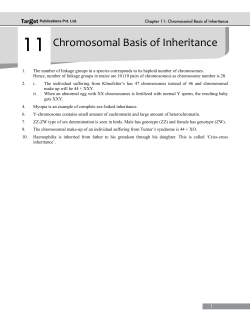
3.3.1: How is DNA Passed Through the Generations?
3.3.1: How is DNA Passed Through the Generations? Steps of Mitosis: o Original cell: o DNA replicates so that there are two copies. o DNA condenses into a compact form called chromosomes. Each chromosome contains two identical copies of DNA called sister chromatids. © 2013 Project Lead The Way, Inc. PBS Activity 3.3.1: How is DNA Passed Through the Generations? – Page 1 o Chromosomes line up at the center of the cell. Fibers attach to each of the sister chromatids that will pull each chromatid to opposite poles of the cell. o Each chromosome separates and the sister chromatids are pulled to the opposite poles of the cell. o The cell splits into two, with both cells having an equivalent and complete collection of chromosomes. © 2013 Project Lead The Way, Inc. PBS Activity 3.3.1: How is DNA Passed Through the Generations? – Page 2 Steps of Meiosis: o Original cell: o DNA replicates so that there are two copies. o DNA condenses into a compact form called chromosomes. Each chromosome contains two identical copies of DNA called sister chromatids. © 2013 Project Lead The Way, Inc. PBS Activity 3.3.1: How is DNA Passed Through the Generations? – Page 3 o Chromosomes pair up with their matching chromosome called homologous chromosomes (one chromosome inherited from the father and one chromosome inherited from the mother). o Homologous chromosomes line up at the center of the cell. Fibers attach to each of the homologous chromosomes that will pull each chromosome to opposite poles of the cell. o Homologous chromosomes are pulled to opposite poles of the cell. © 2013 Project Lead The Way, Inc. PBS Activity 3.3.1: How is DNA Passed Through the Generations? – Page 4 o The cell splits into two, with both cells having one homologous chromosome from each pair. o Chromosomes line up at the center of both cells. Fibers attach to each of the sister chromatids that will pull each chromatid to opposite poles of the cells. © 2013 Project Lead The Way, Inc. PBS Activity 3.3.1: How is DNA Passed Through the Generations? – Page 5 o Each chromosome separates, and the sister chromatids are pulled to the opposite poles of the cells. o Both cells split into two, with the resulting cells each containing a single chromosome set. (Half the chromosomes of the parent cell. This is how each egg cell and sperm cell contains half the chromosomes of body cells. Therefore, when the sperm and egg combine, they contain the correct number of chromosomes.) © 2013 Project Lead The Way, Inc. PBS Activity 3.3.1: How is DNA Passed Through the Generations? – Page 6
© Copyright 2025














